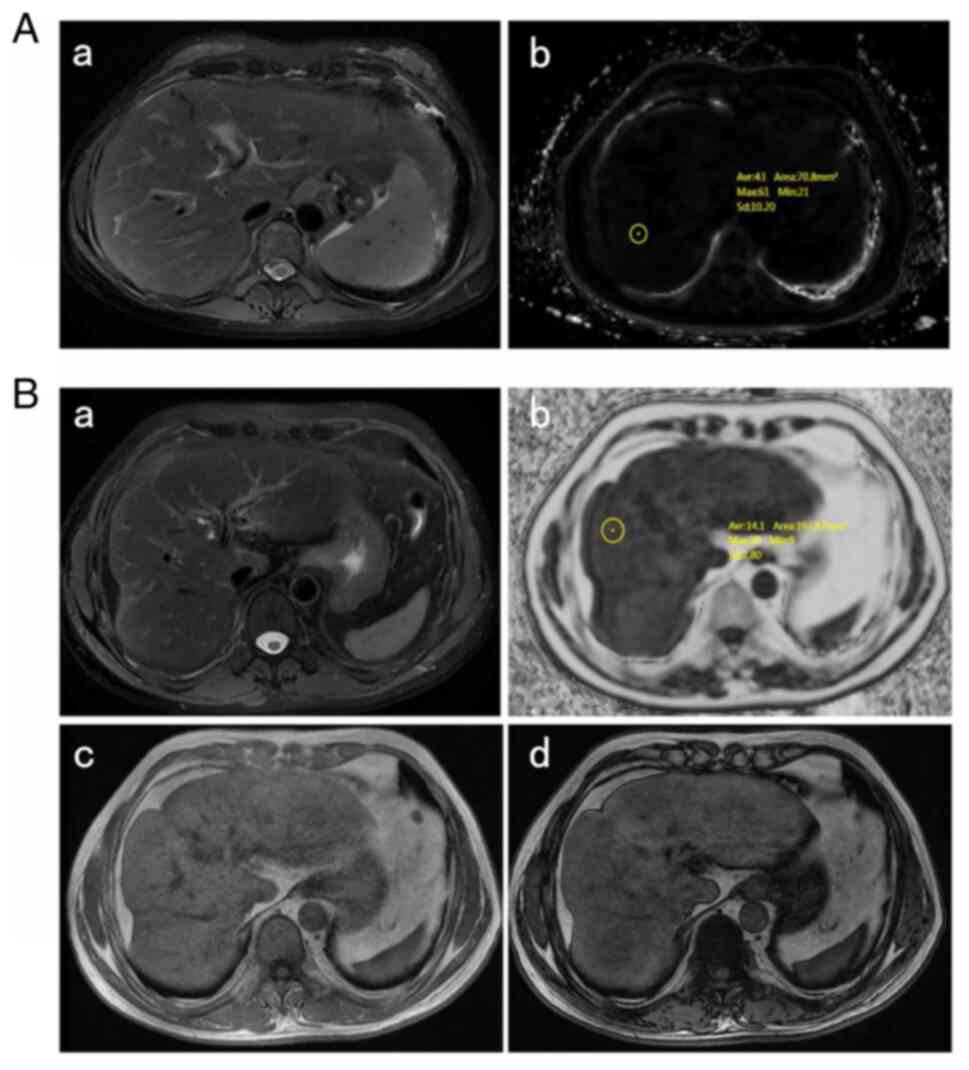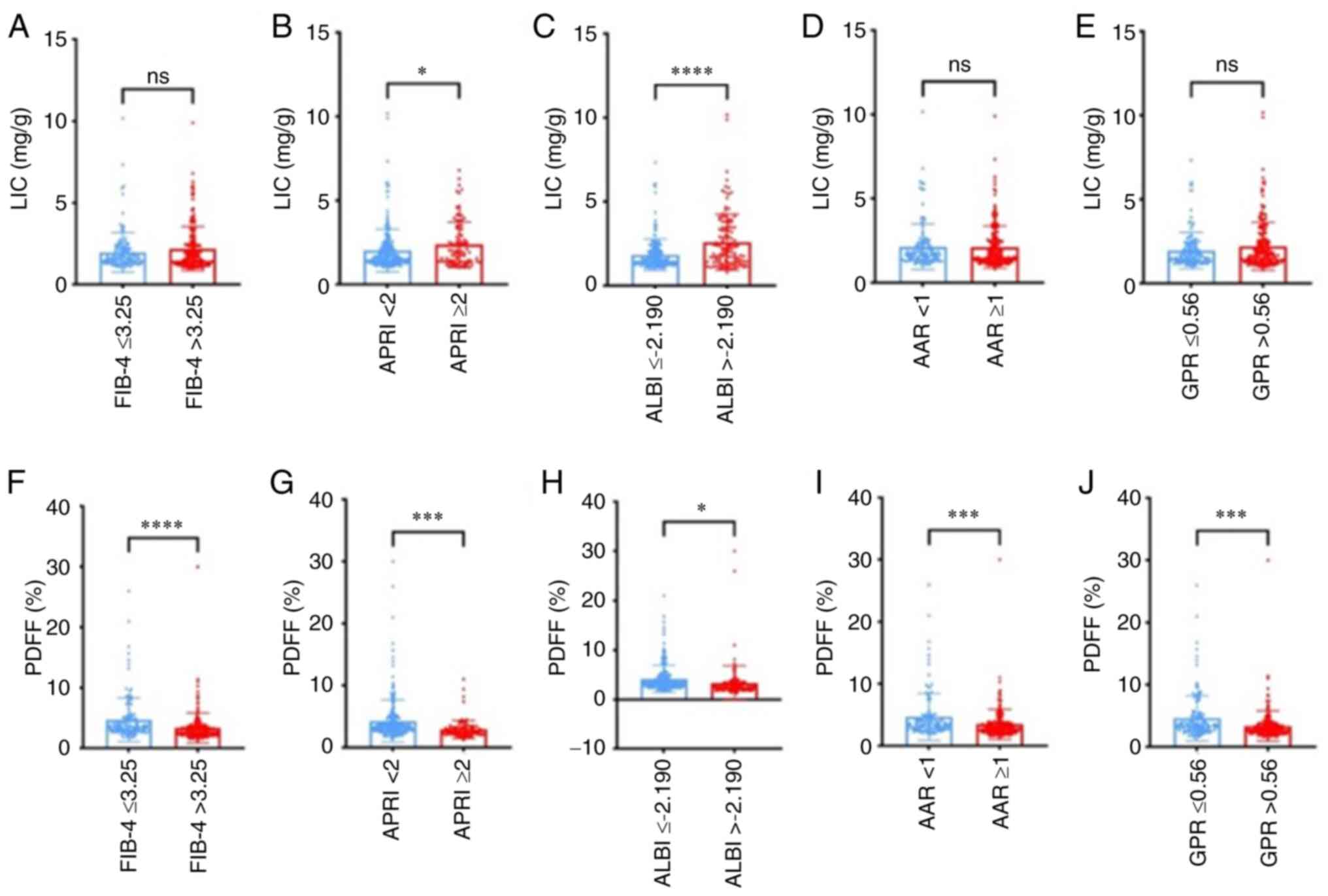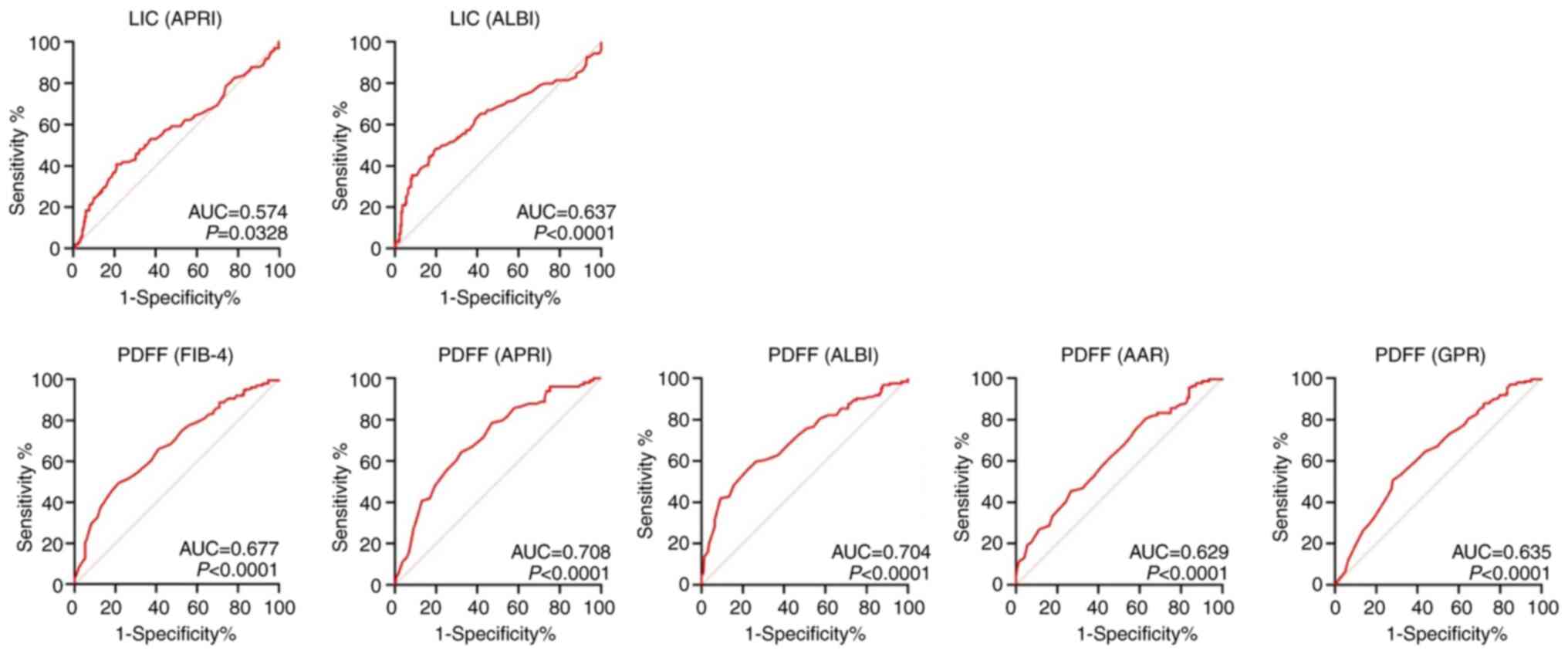|
1
|
Ginzberg D, Wong RJ and Gish R: Global HBV
burden: Guesstimates and facts. Hepatol Int. 12:315–329.
2018.PubMed/NCBI View Article : Google Scholar
|
|
2
|
Ginès P, Krag A, Abraldes JG, Solà E,
Fabrellas N and Kamath PS: Liver cirrhosis. Lancet. 398:1359–1376.
2021.PubMed/NCBI View Article : Google Scholar
|
|
3
|
Ko C, Siddaiah N, Berger J, Gish R,
Brandhagen D, Sterling RK, Cotler SJ, Fontana RJ, McCashland TM,
Han SH, et al: Prevalence of hepatic iron overload and association
with hepatocellular cancer in end-stage liver disease: Results from
the national hemochromatosis transplant registry. Liver Int.
27:1394–1401. 2007.PubMed/NCBI View Article : Google Scholar
|
|
4
|
Guyader D, Thirouard AS, Erdtmann L, Rakba
N, Jacquelinet S, Danielou H, Perrin M, Jouanolle AM, Brissot P and
Deugnier Y: Liver iron is a surrogate marker of severe fibrosis in
chronic hepatitis C. J Hepatol. 46:587–595. 2007.PubMed/NCBI View Article : Google Scholar
|
|
5
|
Wang MM, Wang GS, Shen F, Chen GY, Pan Q
and Fan JG: Hepatic steatosis is highly prevalent in hepatitis B
patients and negatively associated with virological factors. Dig
Dis Sci. 59:2571–2579. 2014.PubMed/NCBI View Article : Google Scholar
|
|
6
|
Sikorska K, Stalke P, Izycka-Swieszewska
E, Romanowski T and Bielawski KP: The role of iron overload and HFE
gene mutations in the era of pegylated interferon and ribavirin
treatment of chronic hepatitis C. Med Sci Monit. 16:CR137–CR143.
2010.PubMed/NCBI
|
|
7
|
Van Thiel DH, Friedlander L, Fagiuoli S,
Wright HI, Irish W and Gavaler JS: Response to interferon alpha
therapy is influenced by the iron content of the liver. J Hepatol.
20:410–415. 1994.PubMed/NCBI View Article : Google Scholar
|
|
8
|
Olynyk JK, Reddy KR, Di Bisceglie AM,
Jeffers LJ, Parker TI, Radick JL, Schiff ER and Bacon BR: Hepatic
iron concentration as a predictor of response to interferon alfa
therapy in chronic hepatitis C. Gastroenterology. 108:1104–1109.
1995.PubMed/NCBI View Article : Google Scholar
|
|
9
|
Zhang J, Lin S, Jiang D, Li M, Chen Y, Li
J and Fan J: Chronic hepatitis B and non-alcoholic fatty liver
disease: Conspirators or competitors? Liver Int. 40:496–508.
2020.PubMed/NCBI View Article : Google Scholar
|
|
10
|
Liu J, Lee MH, Batrla-Utermann R, Jen CL,
Iloeje UH, Lu SN, Wang LY, You SL, Hsiao CK, Yang HI and Chen CJ: A
predictive scoring system for the seroclearance of HBsAg in
HBeAg-seronegative chronic hepatitis B patients with genotype B or
C infection. J Hepatol. 58:853–860. 2013.PubMed/NCBI View Article : Google Scholar
|
|
11
|
Tai DI, Tsay PK, Chen WT, Chu CM and Liaw
YF: Relative roles of HBsAg seroclearance and mortality in the
decline of HBsAg prevalence with increasing age. Am J
Gastroenterol. 105:1102–1109. 2010.PubMed/NCBI View Article : Google Scholar
|
|
12
|
Chiang CH, Yang HI, Jen CL, Lu SN, Wang
LY, You SL, Su J, Iloeje UH and Chen CJ: REVEAL-HBV Study Group.
Association between obesity, hypertriglyceridemia and low hepatitis
B viral load. Int J Obes (Lond). 37:410–415. 2013.PubMed/NCBI View Article : Google Scholar
|
|
13
|
Liu J, Yang HI, Lee MH, Lu SN, Jen CL,
Wang LY, You SL, Iloeje UH and Chen CJ: REVEAL-HBV Study Group.
Incidence and determinants of spontaneous hepatitis B surface
antigen seroclearance: A community-based follow-up study.
Gastroenterology. 139:474–482. 2010.PubMed/NCBI View Article : Google Scholar
|
|
14
|
Shackel NA and McCaughan GW: Liver biopsy:
Is it still relevant? Intern Med J. 36:689–691. 2006.PubMed/NCBI View Article : Google Scholar
|
|
15
|
Regev A, Berho M, Jeffers LJ, Milikowski
C, Molina EG, Pyrsopoulos NT, Feng ZZ, Reddy KR and Schiff ER:
Sampling error and intraobserver variation in liver biopsy in
patients with chronic HCV infection. Am J Gastroenterol.
97:2614–2618. 2002.PubMed/NCBI View Article : Google Scholar
|
|
16
|
Kim KY, Song JS, Kannengiesser S and Han
YM: Hepatic fat quantification using the proton density fat
fraction (PDFF): Utility of free-drawn-PDFF with a large coverage
area. Radiol Med. 120:1083–1093. 2015.PubMed/NCBI View Article : Google Scholar
|
|
17
|
Terrault NA, Lok ASF, McMahon BJ, Chang
KM, Hwang JP, Jonas MM, Brown RS Jr, Bzowej NH and Wong JB: Update
on prevention, diagnosis, and treatment of chronic hepatitis B:
AASLD 2018 hepatitis B guidance. Hepatology. 67:1560–1599.
2018.PubMed/NCBI View Article : Google Scholar
|
|
18
|
Wai CT, Greenson JK, Fontana RJ,
Kalbfleisch JD, Marrero JA, Conjeevaram HS and Lok AS: A simple
noninvasive index can predict both significant fibrosis and
cirrhosis in patients with chronic hepatitis C. Hepatology.
38:518–526. 2003.PubMed/NCBI View Article : Google Scholar
|
|
19
|
Vallet-Pichard A, Mallet V, Nalpas B,
Verkarre V, Nalpas A, Dhalluin-Venier V, Fontaine H and Pol S:
FIB-4: An inexpensive and accurate marker of fibrosis in HCV
infection. comparison with liver biopsy and fibrotest. Hepatology.
46:32–36. 2007.PubMed/NCBI View Article : Google Scholar
|
|
20
|
Johnson PJ, Berhane S, Kagebayashi C,
Satomura S, Teng M, Reeves HL, O'Beirne J, Fox R, Skowronska A,
Palmer D, et al: Assessment of liver function in patients with
hepatocellular carcinoma: A new evidence-based approach-the ALBI
grade. J Clin Oncol. 33:550–558. 2015.PubMed/NCBI View Article : Google Scholar
|
|
21
|
Sheth SG, Flamm SL, Gordon FD and Chopra
S: AST/ALT ratio predicts cirrhosis in patients with chronic
hepatitis C virus infection. Am J Gastroenterol. 93:44–48.
1998.PubMed/NCBI View Article : Google Scholar
|
|
22
|
Lemoine M, Shimakawa Y, Nayagam S, Khalil
M, Suso P, Lloyd J, Goldin R, Njai HF, Ndow G, Taal M, et al: The
gamma-glutamyl transpeptidase to platelet ratio (GPR) predicts
significant liver fibrosis and cirrhosis in patients with chronic
HBV infection in West Africa. Gut. 65:1369–1376. 2016.PubMed/NCBI View Article : Google Scholar
|
|
23
|
Caussy C, Alquiraish MH, Nguyen P,
Hernandez C, Cepin S, Fortney LE, Ajmera V, Bettencourt R, Collier
S, Hooker J, et al: Optimal threshold of controlled attenuation
parameter with MRI-PDFF as the gold standard for the detection of
hepatic steatosis. Hepatology. 67:1348–1359. 2018.PubMed/NCBI View Article : Google Scholar
|
|
24
|
Wood JC, Enriquez C, Ghugre N, Tyzka JM,
Carson S, Nelson MD and Coates TD: MRI R2 and R2* mapping
accurately estimates hepatic iron concentration in
transfusion-dependent thalassemia and sickle cell disease patients.
Blood. 106:1460–1465. 2005.PubMed/NCBI View Article : Google Scholar
|
|
25
|
Henninger B, Alustiza J, Garbowski M and
Gandon Y: Practical guide to quantification of hepatic iron with
MRI. Eur Radiol. 30:383–393. 2020.PubMed/NCBI View Article : Google Scholar
|
|
26
|
Chinese Society of Ultrasound in Medicine,
Oncology Intervention Committee of Chinese Research Hospital
Society and National Health Commission Capacity Building And
Continuing Education Expert Committee on Ultrasonic Diagnosis.
[Guideline for ultrasonic diagnosis of liver diseases]. Zhonghua
Gan Zang Bing Za Zhi. 29:385–402. 2021.PubMed/NCBI View Article : Google Scholar : (In Chinese).
|
|
27
|
Martinelli AL, Filho AB, Franco RF,
Tavella MH, Ramalho LN, Zucoloto S, Rodrigues SS and Zago MA: Liver
iron deposits in hepatitis B patients: Association with severity of
liver disease but not with hemochromatosis gene mutations. J
Gastroenterol Hepatol. 19:1036–1041. 2004.PubMed/NCBI View Article : Google Scholar
|
|
28
|
Piperno A, D'Alba R, Fargion S, Roffi L,
Sampietro M, Parma S, Arosio V, Faré M and Fiorelli G: Liver iron
concentration in chronic viral hepatitis: A study of 98 patients.
Eur J Gastroenterol Hepatol. 7:1203–1208. 1995.PubMed/NCBI View Article : Google Scholar
|
|
29
|
Di Bisceglie AM, Axiotis CA, Hoofnagle JH
and Bacon BR: Measurements of iron status in patients with chronic
hepatitis. Gastroenterology. 102:2108–2113. 1992.PubMed/NCBI View Article : Google Scholar
|
|
30
|
Ito K, Mitchell DG, Gabata T, Hann HW, Kim
PN, Fujita T, Awaya H, Honjo K and Matsunaga N: Hepatocellular
carcinoma: Association with increased iron deposition in the
cirrhotic liver at MR imaging. Radiology. 212:235–240.
1999.PubMed/NCBI View Article : Google Scholar
|
|
31
|
Arosio P, Ingrassia R and Cavadini P:
Ferritins: A family of molecules for iron storage, antioxidation
and more. Biochim Biophys Acta. 1790:589–599. 2009.PubMed/NCBI View Article : Google Scholar
|
|
32
|
Bell H, Skinningsrud A, Raknerud N and Try
K: Serum ferritin and transferrin saturation in patients with
chronic alcoholic and non-alcoholic liver diseases. J Intern Med.
236:315–322. 1994.PubMed/NCBI View Article : Google Scholar
|
|
33
|
Chapman RW, Morgan MY, Laulicht M,
Hoffbrand AV and Sherlock S: Hepatic iron stores and markers of
iron overload in alcoholics and patients with idiopathic
hemochromatosis. Dig Dis Sci. 27:909–916. 1982.PubMed/NCBI View Article : Google Scholar
|
|
34
|
Ferrara F, Ventura P, Vegetti A, Guido M,
Abbati G, Corradini E, Fattovich G, Ferrari C, Tagliazucchi M,
Carbonieri A, et al: Serum ferritin as a predictor of treatment
outcome in patients with chronic hepatitis C. Am J Gastroenterol.
104:605–616. 2009.PubMed/NCBI View Article : Google Scholar
|
|
35
|
Ripoll C, Keitel F, Hollenbach M, Greinert
R and Zipprich A: Serum ferritin in patients with cirrhosis is
associated with markers of liver insufficiency and circulatory
dysfunction, but not of portal hypertension. J Clin Gastroenterol.
49:784–789. 2015.PubMed/NCBI View Article : Google Scholar
|
|
36
|
Mehta KJ, Farnaud SJ and Sharp PA: Iron
and liver fibrosis: Mechanistic and clinical aspects. World J
Gastroenterol. 25:521–538. 2019.PubMed/NCBI View Article : Google Scholar
|
|
37
|
Park SO, Kumar M and Gupta S: TGF-β and
iron differently alter HBV replication in human hepatocytes through
TGF-β/BMP signaling and cellular microRNA expression. PloS One.
7(e39276)2012.PubMed/NCBI View Article : Google Scholar
|
|
38
|
Metwally MA, Zein CO and Zein NN: Clinical
significance of hepatic iron deposition and serum iron values in
patients with chronic hepatitis C infection. Am J Gastroenterol.
99:286–291. 2004.PubMed/NCBI View Article : Google Scholar
|
|
39
|
Younossi ZM, Koenig AB, Abdelatif D, Fazel
Y, Henry L and Wymer M: Global epidemiology of nonalcoholic fatty
liver disease-Meta-analytic assessment of prevalence, incidence,
and outcomes. Hepatology. 64:73–84. 2016.PubMed/NCBI View Article : Google Scholar
|
|
40
|
Fan JG, Kim SU and Wong VW: New trends on
obesity and NAFLD in Asia. J Hepatol. 67:862–873. 2017.PubMed/NCBI View Article : Google Scholar
|
|
41
|
Farrell GC, Wong VW and Chitturi S: NAFLD
in Asia-as common and important as in the west. Nat Rev
Gastroenterol Hepatol. 10:307–318. 2013.PubMed/NCBI View Article : Google Scholar
|
|
42
|
Liu PT, Hwang AC and Chen JD: Combined
effects of hepatitis B virus infection and elevated alanine
aminotransferase levels on dyslipidemia. Metabolism. 62:220–225.
2013.PubMed/NCBI View Article : Google Scholar
|
|
43
|
Wong VW, Wong GL, Chu WC, Chim AM, Ong A,
Yeung DK, Yiu KK, Chu SH, Chan HY, Woo J, et al: Hepatitis B virus
infection and fatty liver in the general population. J Hepatol.
56:533–540. 2012.PubMed/NCBI View Article : Google Scholar
|
|
44
|
Cheng YL, Wang YJ, Kao WY, Chen PH, Huo
TI, Huang YH, Lan KH, Su CW, Chan WL, Lin HC, et al: Inverse
association between hepatitis B virus infection and fatty liver
disease: A large-scale study in populations seeking for check-up.
PLoS One. 8(e72049)2013.PubMed/NCBI View Article : Google Scholar
|
|
45
|
Mak LY, Seto WK, Hui RW, Fung J, Wong DK,
Lai CL and Yuen MF: Fibrosis evolution in chronic hepatitis B e
antigen-negative patients across a 10-year interval. J Viral Hepat.
26:818–827. 2019.PubMed/NCBI View Article : Google Scholar
|
|
46
|
Charatcharoenwitthaya P, Pongpaibul A,
Kaosombatwattana U, Bhanthumkomol P, Bandidniyamanon W, Pausawasdi
N and Tanwandee T: The prevalence of steatohepatitis in chronic
hepatitis B patients and its impact on disease severity and
treatment response. Liver Int. 37:542–551. 2017.PubMed/NCBI View Article : Google Scholar
|












